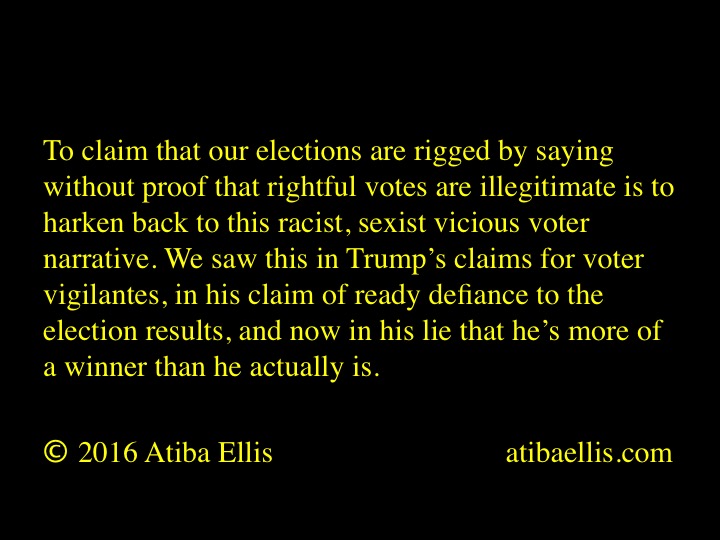I taught Dred Scott v. Sanford this week. As a teacher and scholar of civil rights, it’s my job to teach the constitutional canon and how Dred Scott, and cases fairly called its progeny, misshaped our idea of equality. And while it is unsurprising to teach this canon in a course at Marquette Law on “Contemporary Perspectives on Civil Rights,” or in any civil rights or constitutional law course, what was different this time is that I taught Dred Scott for the first time in the Era of Trump.
Of course, I’ve taught the case before in first-year Property, in my Race Racism & American Law seminar, in public lectures at WVU Law, and in seminars on three different continents. I’ve written about Dred Scott in articulating my view of “tiered personhood” and blogged about its contemporary relevance. And it is fair to say that, after teaching for over 10 years, on some level, I was used to rehearsing the case often called “pure constitutional evil.”
But this time was different.
I walked into class, ready with my practiced confrontation of this intellectual monument to Chief Justice Roger Tawny. And after answering follow-up questions from last class about a case that enforced the racial classification system on which slavery depended, I began Dred Scott by reminding my students that we were studying the origin story of American white supremacy.
But before opening the casebook, I recalled that a student suggested we frame the conversation by watching a recent viral video of Univision News journalist Ilia Calderón. I had attempted to show the video in the class prior, but due to technical difficulties, this video prefaced our discussion of Dred Scott—which was not my original plan but proved more than appropriate for discussing the case in today’s political climate.
After the video ended, I found myself dumbstruck. This Klansman and his wife had the audacity to claim his superiority based purely on the color of his skin (which echoed the race classification cases from last class). He called her a “mongrel” and a “n**ger” and threatened to burn her out of his land. And despite their claims of racial superiority, religious exceptionalism, and entitled grievance, accompanied by threats of rebellion against a government that attacks their heritage and takes their stuff, the couple claimed they are not racist and the Klan is not a hate group.
In that moment, I remembered that Dred Scott is more than precedent. It is the anti-gospel of slavery, echoed anew by this Klansman, as an effort to tell Ms. Calderón (and all of us who can imagine her situation) to keep our place or be ready to burn. My own anger welled up, and my sadness too because that Klansman’s words reminded me of the times I had been called “n**ger” by white people, or told during an internship that “deliveries were around back,” or called “Big boy” by a white senior partner in front of my peers. Watching this Klan couple’s loathing reminded me that their hearts are full of twisted grievance and their minds are the heirs of the racial hierarchy enforced by Dred Scott.
To calm myself after the video ended, I had to let silence overcome the room. As far as I could tell, the students felt some mix of anger, pity, and shock. After this pause, I explained in both legal and moral terms that the structures of racism and the ideology of white supremacy cannot be thought of in isolation. The anti-gospel of the Klan and the words of Chief Justice Tawney must be thought of as parts of a whole.
Indeed, to read Dred Scott is to read a blueprint for structural racism. American citizenship is defined to exclude all black people. Slaves are a property that can be treated with near impunity. People of color do not belong in the American political community. A black person was “so far inferior that they had no rights which the white man was bound to respect.” These are the lessons of Dred Scott, which followed through on the seeds sown in the Constitution of 1789, and which took amendment and 160 years of activism, struggle, and needless death to reverse.
And though the law has changed, the reversal is incomplete. This era—these times we live in now—echo that evil. The boundaries of personhood continue to be drawn to exclude not only race, but also gender and sexual orientation. The borders of the political community are being redrawn to wall off children who live up to the egalitarian American creed but have imperfect immigration status. The Klan and Nazis march with the impunity offered through mealy-mouthed accommodation from the White House. The structures of mass incarceration, disenfranchisement, and police brutality were built according to the same blueprint of white supremacy as Dred Scott, yet there are those who defend these still-functional monuments to slavery and Jim Crow as “law and order.”
Dred Scott and its ideological and doctrinal progeny are still with us. As much as we have moved away from being an apartheid state, as much as we have asserted through the Constitution and laws that we believe in equality, there are those of us who, by their torches, their twisted ideologies, and their policies seek to bring us back to that time. Their fire and fury—both cultural and legal—still try to burn out equality in the name of nativism and racial superiority. This is the era in which we live.


